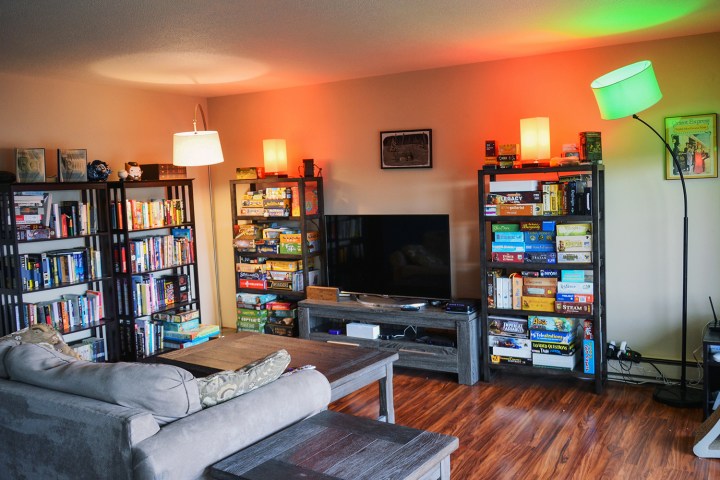Once the days start shortening and cities start getting buried in snow, you may be feeling a little bit down. Getting that much less sunlight throws people for a loop. After months of these conditions in northern climes, it can be downright depressing. Specialized lighting has long been held as an antidote for this seasonal affective disorder, but can everyday smart lights rise to the task?
Hint: Yes — but maybe not in the way you think.
Disclaimer: We aren’t anything close to being doctors. If seasonal affective disorder is hitting you hard, talk to your doctor and find the best treatment for you. It’s entirely possible your particular depression isn’t tied to the season.
What is seasonal affective disorder?
Seasonal affective disorder is more than just being bummed that it’s getting dark early and you can’t go outside. This kind of depression significantly affects your ability to sleep, concentrate, maintain energy levels, and regulate appetite. These symptoms need to arise in at least two consecutive years to establish the trend. It’s speculated that sunlight and vitamin D help us maintain regular serotonin and melatonin levels. When we lose that, our brain chemistry gets knocked out of whack.
What is phototherapy?
Phototherapy is a means of treating seasonal affective disorder with exposure to bright light early in your day. Don’t worry, you don’t have to stare into a light bulb and be stuck seeing spots all day long. Exposure to these lightboxes can be indirect, so you can just read in front of the lightbox for about a half-hour when you first wake up. You do need to keep your eyes open for it to work, however. Proper SAD lightboxes have UV filters so your eyes and skin don’t get damaged in the process.
Do smart lights help with seasonal affective disorder?
Many smart light manufacturers, like Nanoleaf, have leaned into this science with product features that help support healthy circadian rhythms. The lights adjust brightness and color temperature relative to the time of day in order to mimic what the sun would be doing if it weren’t utterly blotted out by clouds and snow.
Color temperature plays a role in seasonal affective disorder light therapy, but this is the easiest challenge for smart bulbs to tackle. In order to mimic daylight temperature, light needs to be in the 5000K to 6000K range, and adjustable white smart bulbs are routinely able to go from 2200K to 6500K. Studies have shown that visible narrow-band blue light can confer benefits similar to traditional SAD lightboxes. That kind of light is well within the abilities of smart lights.
Full-spectrum bulbs include large portions of light frequencies that are often left out. In order to determine a bulb’s suitability to treat seasonal affective disorder, you can use something called the color rendering index. CRI is a rating system that goes from 1 to 100 to determine how closely any given light source matches natural sunlight. Smart lights can get up to around 92, which is pretty good, and unsurprising given the amount of color range they cover. Whichever brand of bulb you go with for this treatment, you want to find full-spectrum white light. You can find the CRI rating of most LED bulbs at Energy Star if it’s not already on the box.

Brightness is a bigger challenge. The brightness of bulbs is rated in lumens, and seasonal affective disorder therapies use lux. Lux is a measure of brightness applied to a certain area, whereby 1 lux is equal to 1 lumen per square meter. You can use a calculator to figure out the lux rating of a light in any given arrangement. If you’re looking at the average 1,000-lumen smart bulb set at a reasonable distance of 2 feet, you would need an array of 23 bulbs to get the recommended exposure of 10,000 lux. You can bring that number of bulbs down by narrowing the light beams or getting closer to the bulbs, but suffice to say, this isn’t a reasonable solution.
Though you might not be able to count on smart lights as a tried-and-true treatment for seasonal affective disorder for the brightness issue alone, there are studies to support them as a way of improving health and productivity.
Even the very best light therapy lamps will only be a rough approximation of daylight. Lights emit at a consistent frequency, but sunlight has regular ebbs and flows through the day that can’t be easily reproduced. With any luck, a proper light therapy lamp supplemented by using home smart lights should be enough to tide you over until the spring.
Sometimes seasonal affective disorder can be worsened just by gloomy days. Smart lights can help make your home feel more warm and cozy, and that can help fight off the wintry blues. They’re no substitute for proper light therapy, but smart lights might be able to lift your spirits on the coldest days of the year.
Editors' Recommendations
- Yale’s newest smart lock is designed for renters
- The Skylight Cal Max is a 27-inch smart calendar that might replace your smart display
- Pawport brings security (and smarts) to your existing pet door
- I checked out Govee’s new AI smart lights and now I want them everywhere
- Samsung Ballie is a rolling smart home hub with a built-in projector





